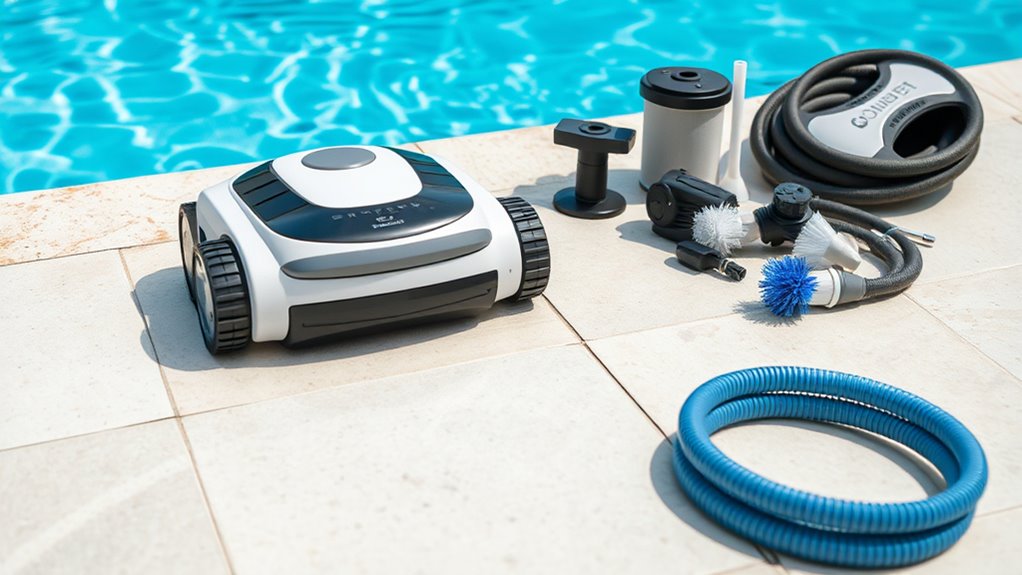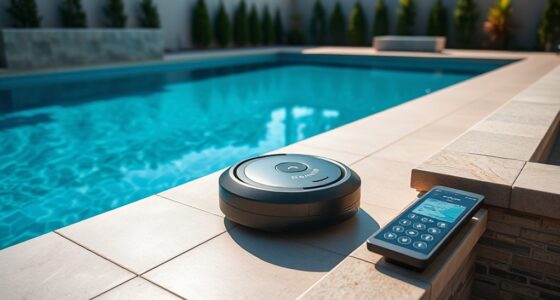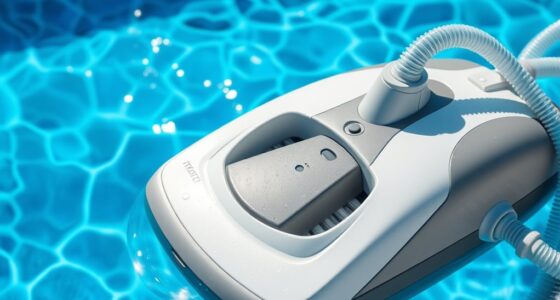To clean and store your robotic pool cleaner, start by turning it off and unplugging it. Remove the filter basket, discard debris, and rinse it thoroughly. Clean the body, brushes, wheels, and tracks with water, ensuring all dirt and algae are gone. Dry the unit completely, especially the brushes and internal parts, before storing it in a cool, dry place away from sunlight. Following these steps helps keep your cleaner in top shape; explore further to master all tips.
Key Takeaways
- Turn off and unplug the cleaner before cleaning to ensure safety.
- Remove and rinse the filter basket thoroughly with a garden hose, then allow it to dry completely.
- Clean the brushes, wheels, and body with a gentle spray and soft brush to remove debris and algae.
- Wipe excess water, air dry in a well-ventilated area, and store in a cool, dry place away from sunlight.
- Regularly inspect parts, replace worn components, and perform routine maintenance to prolong device lifespan.
Turn Off and Unplug the Device
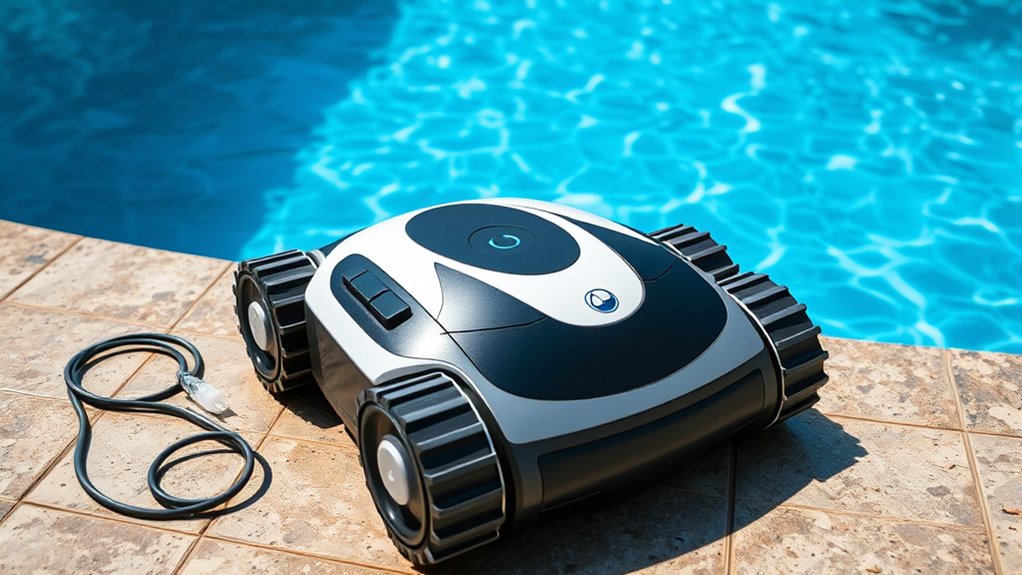
Before you begin cleaning or storing your robotic pool cleaner, you should turn it off and unplug it from the power source. This step is essential to guarantee safety and prevent accidental activation. Locate the power button on your device and press it to turn off the cleaner completely. Once powered down, unplug the power cord from the outlet to eliminate any risk of electrical shock. Taking these safety precautions protects you from potential hazards, especially if water or debris has accumulated during use. Always handle the device carefully after turning it off, and avoid disconnecting the power cord by pulling on the cable itself. Properly turning off and unplugging your robotic pool cleaner is the first critical step toward safe cleaning and storage. Additionally, ensuring electrical safety practices helps prevent potential damage to the device or injury during maintenance. Incorporating imagination into your routine can also help visualize the proper steps for safe handling and storage, making the process smoother and more effective. Remember that proper maintenance can extend the life of your cleaner and ensure it functions efficiently when needed. Being aware of electrical safety standards can further enhance your safety during these procedures. Using environmentally safe cleaning methods can also help preserve the integrity of the device and reduce risks during maintenance.
Remove and Clean the Filter Basket
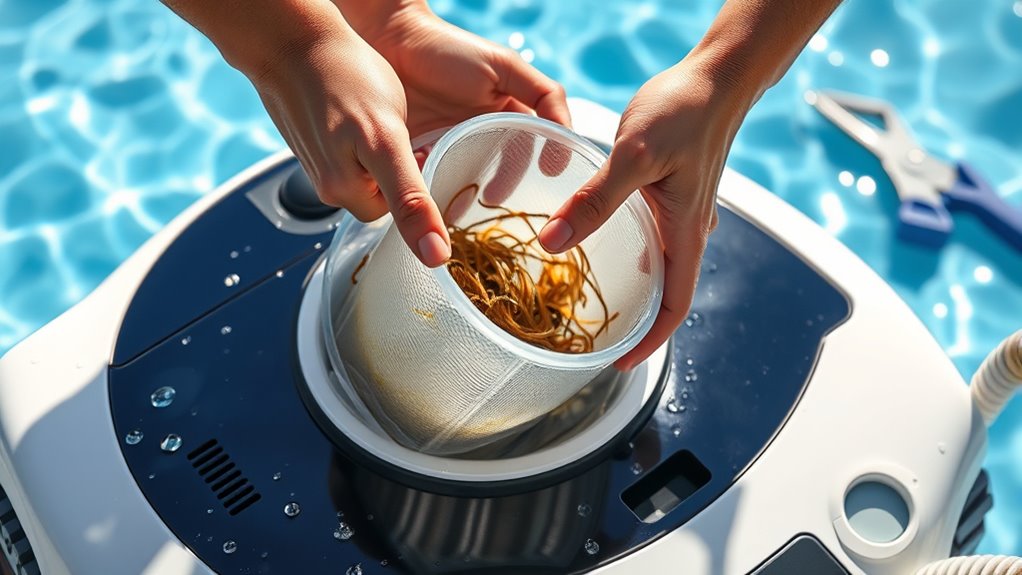
To clean your robotic pool cleaner, start by accessing the filter basket, usually located on the underside or side of the device. Carefully remove the basket and rinse it with a garden hose to clear out debris. Make sure to clean the filter thoroughly to keep your cleaner running efficiently. Regularly inspecting the filter for clogged particles can help prevent potential malfunctions. Additionally, using appropriate cleaning tools can make this process more effective and less time-consuming. Proper maintenance of the filter basket ensures optimal air purifier performance and prolongs the lifespan of your cleaner. Incorporating routine checks with automated insights can further optimize your cleaning schedule and device longevity. Regular cleaning and maintenance can also help maximize the suction power of your robotic cleaner, ensuring it works at peak efficiency.
Accessing the Filter Basket
Accessing the filter basket is a simple yet important step in maintaining your robotic pool cleaner. To do this, locate the filter access panel on your device, usually on the top or side. Open the panel carefully to expose the basket. Basket removal involves gently lifting or sliding out the filter container, ensuring you don’t force it, which could cause damage. Once removed, you can inspect the basket for debris or clogs. This process allows you to easily reach the filter basket for cleaning or replacement. Regularly accessing the filter basket helps keep your cleaner functioning efficiently and prevents potential malfunctions caused by debris buildup. Additionally, routine inspection of the filter condition can help identify early signs of wear or damage. Proper maintenance of the filter basket aligns with air purifier maintenance dos and don’ts, ensuring optimal performance and longevity of your cleaner. Incorporating regular cleanings of the filter basket can also improve the overall efficiency of your pool cleaner, especially when combined with other Volkswagen Tuning techniques to optimize device performance. Staying informed about robotic pool cleaner technology can help you better understand how to care for your device and maximize its lifespan.
Cleaning the Filter Properly
Have you ever wondered how to guarantee your robotic pool cleaner works at its best? Proper filter maintenance is key. Start by removing the filter basket from your cleaner. Carefully discard any debris, leaves, or dirt trapped inside to ensure maximum debris removal. Rinse the filter with a hose to remove stubborn dirt and grime, taking care to clean all crevices. Avoid using harsh chemicals, as they can damage the filter material. Once thoroughly cleaned, let the filter dry completely before reinserting it into the cleaner. Regular cleaning prevents clogs, improves suction, and extends the life of your robotic pool cleaner. Consistent filter maintenance keeps your device running efficiently and ensures your pool stays spotless.
Rinse the Body and Brushes Thoroughly
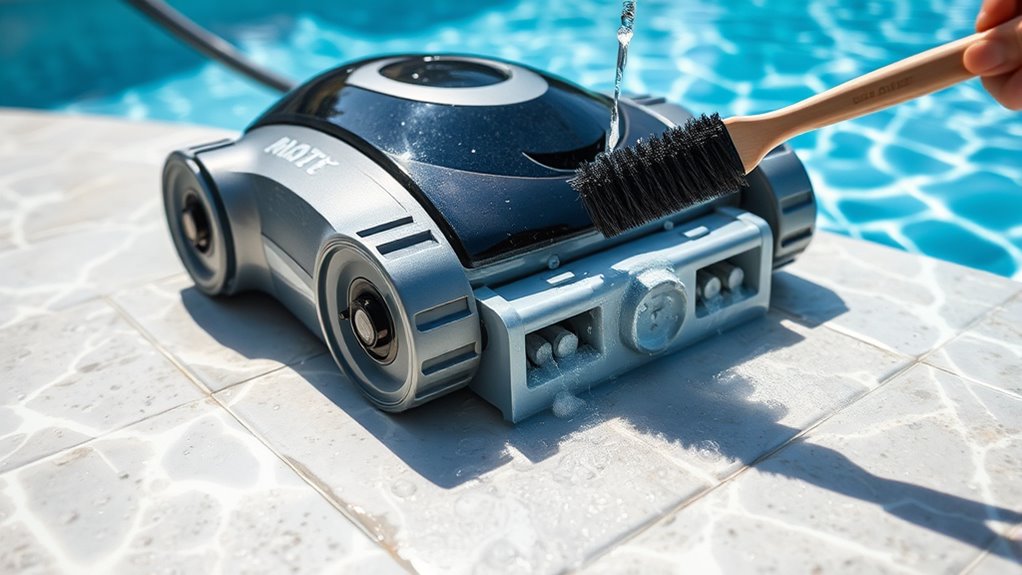
After removing the filter basket, you should rinse the body and brushes thoroughly to eliminate debris and dirt. Use a gentle water spray to clean these parts without damaging any components. This step ensures your cleaner stays in top condition for the next use. To further maintain optimal performance, consider inspecting and cleaning the internal components regularly. Regular maintenance of smart home utilities can also help in monitoring and managing your pool cleaner’s efficiency remotely. Additionally, ensuring your merchant services are secure and reliable can streamline the purchase of replacement parts or maintenance supplies. Performing routine checks on filtration systems can prevent clogs and maintain suction efficiency. Incorporating proper juice cleansing practices can also contribute to overall wellness and longevity of your equipment.
Remove Debris and Dirt
To guarantee your robotic pool cleaner functions at its best, it’s important to remove debris and dirt from its body and brushes regularly. Start by inspecting the cleaner and removing any visible debris stuck on the brushes or body. This helps prevent clogging and improves debris removal efficiency. Ensure you rinse the entire unit thoroughly with clean water, paying special attention to the brushes, wheels, and filters. Proper filter maintenance is vital; clean or replace filters as needed to maximize performance. Regularly removing debris not only keeps your cleaner running smoothly but also extends its lifespan. Keep a close eye on areas prone to dirt buildup, and make it a habit to perform these tasks after each use for peak operation.
Use Gentle Water Spray
Using a gentle water spray is an effective way to thoroughly rinse your robotic pool cleaner’s body and brushes. This method helps remove remaining dirt, algae, and debris without damaging sensitive parts. Be sure to target all surfaces, paying special attention to the brushes and wheels. Using a gentle water spray also helps maintain ideal cleaning frequency by preventing buildup that can reduce performance. Avoid high-pressure streams, which can dislodge parts or cause wear over time. Rinsing after each cleaning session ensures your device stays in top shape and prolongs its lifespan. Incorporating proper maintenance into your regular cleaning routine, especially after heavy use or pool algae blooms, helps keep your robotic cleaner functioning smoothly and efficiently. Regularly inspecting and understanding tuning laws can prevent potential damage caused by improper handling or cleaning techniques. Additionally, ensuring the correct cleaning techniques are followed reduces the risk of damage and extends the device’s operational life. Proper rinsing and maintenance can also support the noise levels of modern heat pumps, as well-maintained equipment tends to operate more quietly and efficiently. Moreover, using appropriate cleaning tools can further enhance the cleaning process and protect delicate components.
Check and Clean the Wheels and Tracks
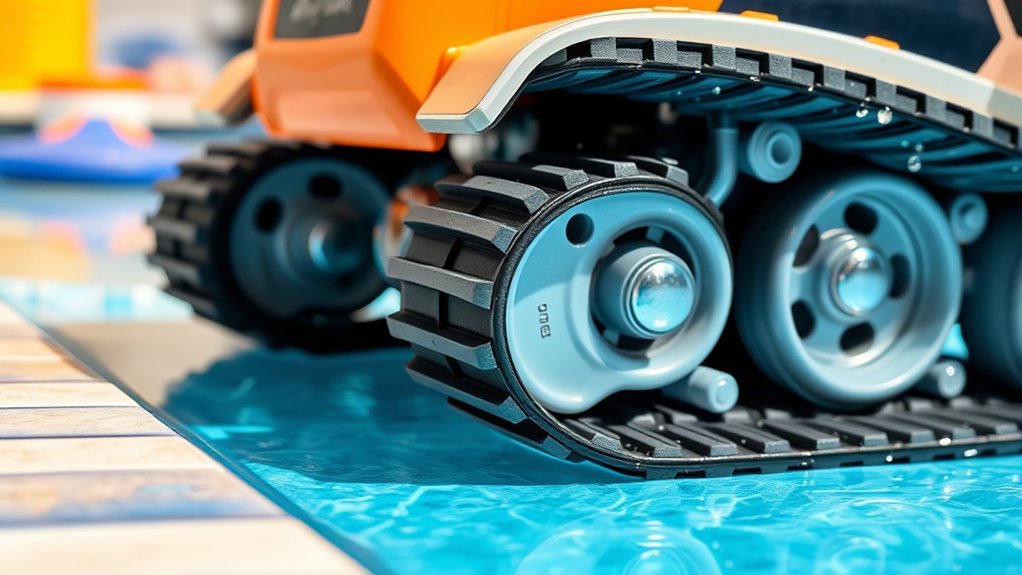
Regularly checking and cleaning the wheels and tracks of your robotic pool cleaner guarantees ideal performance. Start with wheel maintenance by removing dirt, debris, and algae buildup that can hinder movement. Use a soft brush or cloth to gently scrub the wheels, ensuring they spin freely. During track inspection, look for obstructions or embedded debris that might affect traction. Clear any debris stuck in the tracks, and wipe them down with a damp cloth. Keeping the wheels and tracks clean prevents unnecessary strain on the motor and extends your cleaner’s lifespan. Regular maintenance also helps identify early signs of wear and tear. Make this a routine part of your pool cleaning schedule to ensure your robotic cleaner operates smoothly and efficiently every time. Additionally, understanding the location of your pool and its surrounding environment can help you anticipate areas prone to debris buildup and prioritize cleaning efforts.
Inspect and Replace Worn Parts if Necessary
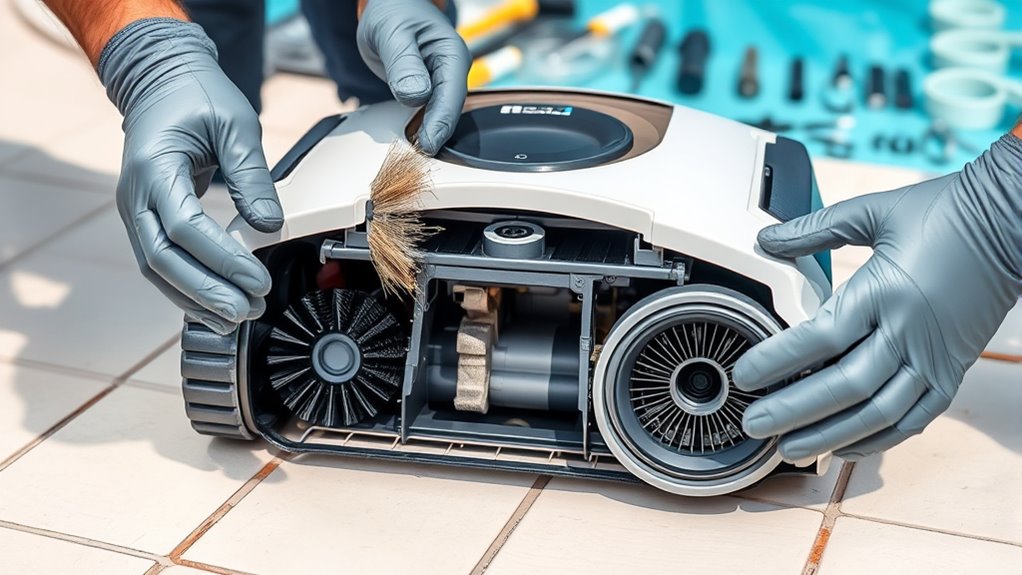
Inspecting your robotic pool cleaner for worn or damaged parts is essential to maintaining ideal performance. Use an inspection checklist to identify issues like cracks, frayed cables, or worn brushes. Check seals and wheels for signs of deterioration, ensuring they move smoothly. Follow the replacement guidelines provided by the manufacturer—if parts show significant wear or damage, replace them promptly. Regular inspection helps prevent breakdowns and keeps your cleaner operating efficiently. Keep in mind that neglecting worn components can lead to reduced cleaning power or motor failure. By staying vigilant and replacing parts as needed, you extend your cleaner’s lifespan and maintain superb pool cleanliness. Always refer to your user manual for specific inspection points and replacement instructions tailored to your model.
Dry the Cleaner Completely Before Storage
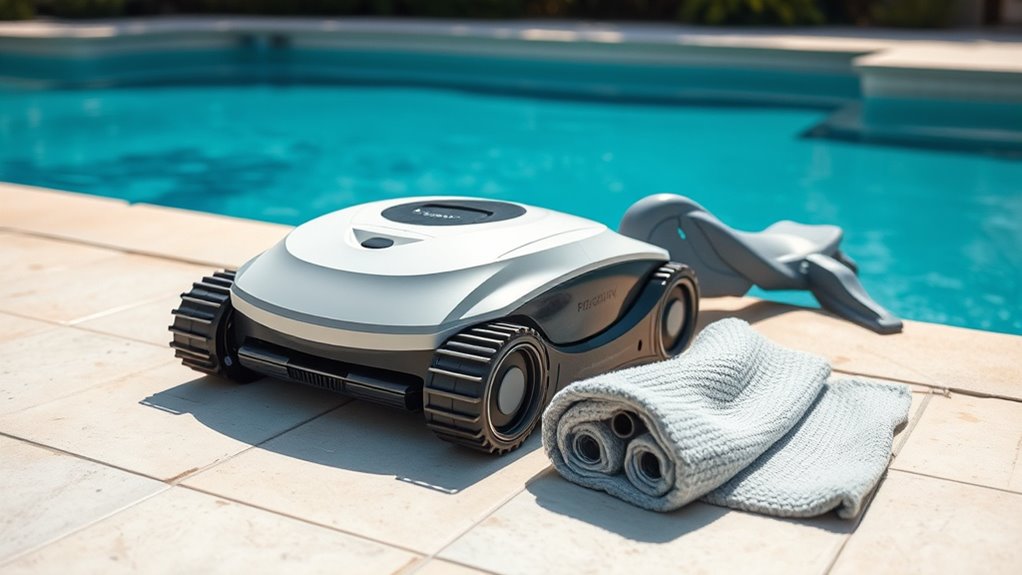
Before storing your robotic pool cleaner, it’s essential to guarantee it’s completely dry to prevent mold, corrosion, and damage. Ensuring thorough dryness provides the best dryness assurance, which is crucial for proper storage preparation. Use a soft cloth to wipe off excess water and allow the cleaner to air dry in a well-ventilated area. Pay special attention to crevices and brushes where moisture can linger. Avoid rushing the drying process, as residual moisture can lead to mold growth or corrosion over time. Once you’re confident it’s fully dry, you can store the cleaner safely, knowing it’s protected from potential damage caused by moisture. Proper drying is a critical step to extend your cleaner’s lifespan and keep it in prime condition.
Store in a Cool, Dry Place Away From Sunlight
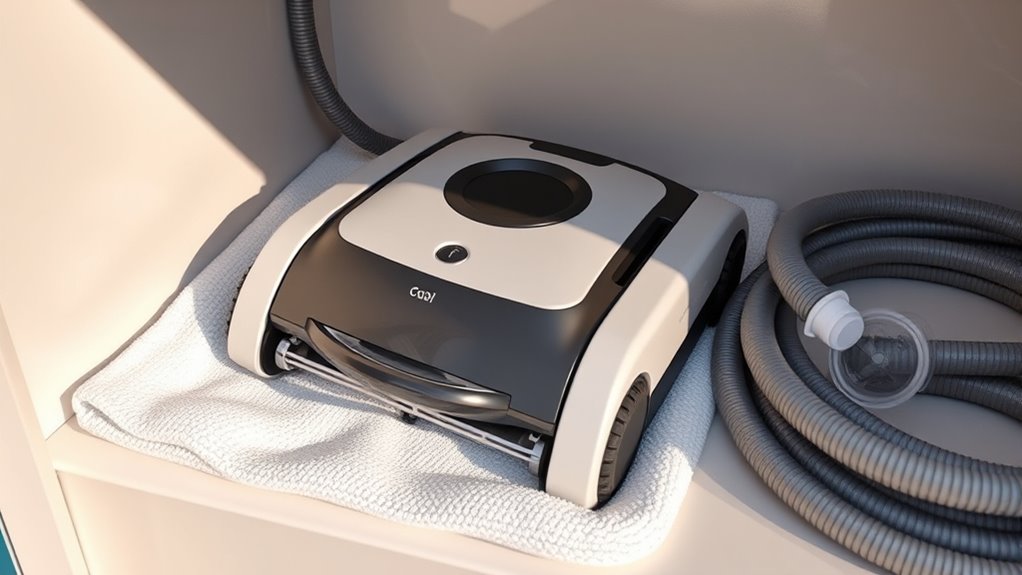
Storing your robotic pool cleaner in a cool, dry place is essential to maintain its performance and longevity. Exposure to sunlight can degrade plastic components and cause fading, while high humidity promotes mold and corrosion. To guarantee ideal storage, consider these tips:
- Choose a location with minimal sunlight exposure
- Ensure good airflow to control humidity levels
- Use a storage cabinet or shelf away from outdoor elements
- Keep the cleaner off the floor to prevent moisture contact
- Avoid areas with temperature fluctuations that could damage internal parts
Perform Regular Maintenance Checks
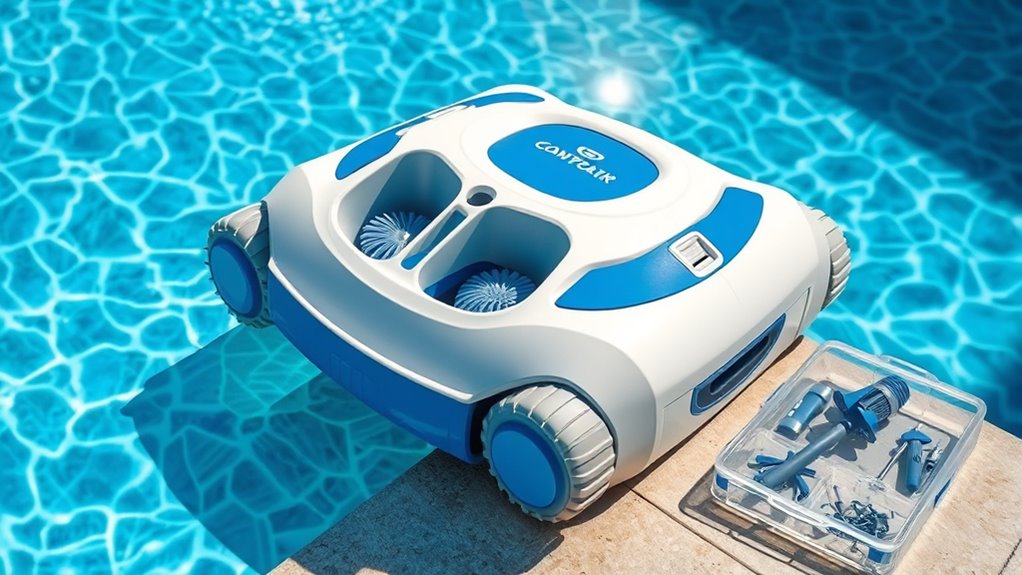
Performing regular maintenance checks is essential to keep your robotic pool cleaner operating at its best. You should inspect the unit for debris, ensure the brushes are clean, and verify the wheels turn smoothly. Pay close attention to battery maintenance—charge the battery properly and avoid leaving it drained for long periods. Also, check for software updates; manufacturers often release updates to improve performance and fix bugs. Regularly testing these aspects prevents breakdowns and extends your cleaner’s lifespan. Use the table below to guide your routine:
| Check | Action | Frequency |
|---|---|---|
| Battery Maintenance | Charge fully, avoid deep discharges | Weekly |
| Software Updates | Download latest firmware | Monthly |
| Brush & Wheel Inspection | Clean and inspect for damage | Bi-weekly |
| Filter Cleaning | Remove debris and rinse | After each use |
| Overall Unit Inspection | Look for cracks or loose parts | Monthly |
Frequently Asked Questions
How Often Should I Clean My Robotic Pool Cleaner?
You should clean your robotic pool cleaner regularly, following a proper maintenance schedule. Typically, cleaning frequency depends on your pool’s usage and debris levels, but it’s recommended to inspect and clean it at least once a week. If your pool gets heavy debris or if you notice reduced performance, clean it more often. Consistent maintenance ensures peak operation and extends your cleaner’s lifespan.
Can I Leave the Cleaner in the Pool During Off-Season?
You shouldn’t leave your robotic pool cleaner in the pool during the off-season. For seasonal storage, it’s best to remove it, clean it thoroughly, and store it in a dry, cool place. Use a pool cover to protect your pool during winter, but always take the cleaner out first to prevent damage from freezing or debris. Proper storage makes certain your cleaner stays in good condition for the next swimming season.
What Cleaning Products Are Safe to Use on My Robotic Cleaner?
In the age of high-tech gadgets, you want to keep your robotic pool cleaner in top shape. Stick to cleaning solutions that are safe detergents and specifically designed for pool equipment. Avoid harsh chemicals like bleach or abrasive cleaners, which can damage the device. Use a soft cloth and mild soap for routine cleaning, ensuring your robot stays efficient and long-lasting. Always consult your manufacturer’s guidelines for the best results.
How Do I Troubleshoot Common Issues With My Robotic Pool Cleaner?
When troubleshooting your robotic pool cleaner, start by checking the battery maintenance; verify it’s charged properly and connections are secure. If it’s not cleaning effectively, inspect the brushes and replace any worn ones to restore performance. Also, clean the filters and remove debris that may block movement. Regular maintenance like this helps keep your cleaner running smoothly, saving you time and preventing future issues.
Is It Necessary to Replace Parts Regularly for Optimal Performance?
Imagine your robotic pool cleaner as a trusted partner, working tirelessly beneath the water’s surface. To keep it performing at its best, part replacement isn’t always necessary but should follow a regular maintenance schedule. This proactive approach prevents unexpected breakdowns and ensures smooth operation. By monitoring wear and tear, you can decide when to replace parts, maintaining ideal performance without overdoing it, just like caring for a valued companion.
Conclusion
By taking a little time to care for your robotic pool cleaner, you’re gently ensuring it stays in top shape. Regular cleaning and proper storage act like a soothing lullaby, keeping your device happy and ready for its next swim. Think of it as giving your cleaner a well-deserved rest, so it can keep shining and making your pool sparkle effortlessly. With this gentle attention, your pool days will always feel fresh and inviting.
